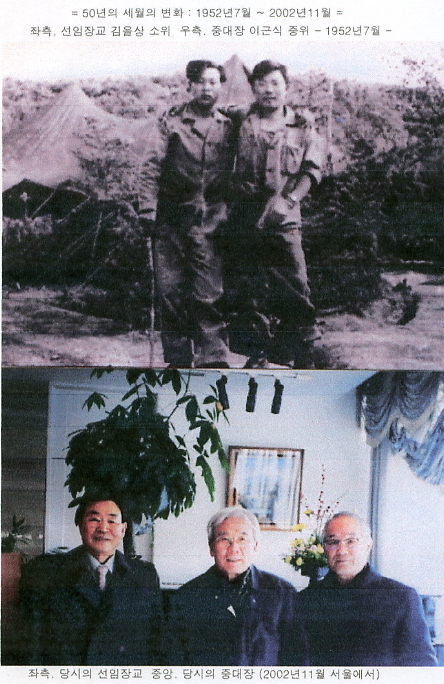In today's international debate over China's development model, a commonly heard term is "state capitalism,' and one oft-cited example of this is the country's development of high-speed railways.
Yet, in this issue of Caixin we report on exorbitant prices paid for bathroom fixtures on new bullet trains, further evidence if any were needed of the ills of state-led market development. In light of such abuses, a closer look at state capitalism is timely.
There are two schools of thought in China on state capitalism.
One group of scholars denies state capitalism is the reason for China's economic success. Instead, they argue, the driving forces were market dynamics unleashed by over 30 years of rural reform, private-sector growth, the national policy to open up and globalization. They say that to attribute success to state-led capitalism would be to misunderstand the past and mislead decision-making in the future.
The other school supports letting state capital shape the market, particularly in strategic industries. It sees state-owned enterprises as the cornerstone of China's spectacular growth. Analysts in this group do not use the term "state capitalism,' but they agree with the philosophy.
The concept is familiar to Chinese economists. Simply put, it means state resources, backed by political power, enter the market and edge out private capital to dominate. In classical political economy, state capitalism is typically seen as emerging in the later stages of capitalism.
By contrast, in the early years of centrally planned economies, state capital generally was first targeted at taking command of key sectors. In the political platform set out by the Chinese Communist Party in 1949, in effect the country's interim constitution, state capitalism meant an economic system of co-operation between state and private capital.
It provided that, "where necessary and possible, private capital should be encouraged to develop in the direction of state capitalism.' Of course, all forms of capitalism, including state capitalism, were in effect rejected under the Soviet-style economic model that China adopted afterwards.
Since the launch of economic reforms, especially in the last 10 years, China has seen a revival of state capitalism. However, it has only been part of wider market development. It must not become the country's prevailing direction and definitely not its goal. Yet, today, state-owned enterprises dominate China's economy and control all its strategic sectors.
The state's heavy hand creates and sustains monopolies, stifles competition and undermines a fair market. There is ample evidence to prove that state capital is less efficient than private capital. Moreover, it creates room for government departments and officials to seek personal gain. The series of corruption and abuse of power scandals in China's development of a high-speed railway network is clear evidence of a sick system.
The degree of state intervention in a capitalist system differs, of course. In its extreme, a government can succeed in oppressing all private enterprises except those it colludes with. Without effective curbs, China's state capitalism may well become crony capitalism.
State enterprises can play a useful role in the market, especially in industries that favor natural monopolies. But a well-developed market needs to protect fair play. As the economist Mancur Olson put it, a market economy requires fair rights and the absence of unfettered power. The unchecked growth of state capital is in fact incompatible with China's chosen model of a socialist market economy.
As early as 1999, in fact, policymakers decided to make strategic adjustments. The fourth plenary session of the party's 15th Central Committee called on state-owned capital to be pulled out of all industries except a minority of sectors where a government presence was essential. But the implementation of this decision has been desultory.
The reason for this is the sticky nature of certain enterprises. Because of their ties to government power, enterprises that deploy state-owned capital have easy access to financial support and government contracts; they can also lobby decision-makers and manipulate laws to their own advantage.
They are in effect special interest groups posing as market players, and their presence distorts the market. The drawbacks of this model of development today are too numerous to count. We must end it, insist on reform and nurture the development of the private sector. State-owned capital must be forced to retreat from competitive industries.
China's economy has reached its limits under this outdated model of development. Whether or not the country can engineer a new path of growth and avoid the middle-income trap will depend on its determination to transform itself.
The deployment of state-owned capital has never been China's stated national policy. Yet, so tenacious is state capitalism that it continues to extend its influence.
The international attention today on the "rise of state capitalism' needs to be taken with a grain of salt. Instead of being seen as legitimizing state capitalism, these comments should be taken as a warning of the perils that threaten Chinese prosperity. And they should pull people together to push for reform.
If our pace of reform continues to lag behind the expansion of state-owned capital, we will soon hear talk of not the rise, but a crisis, of state capitalism.
Source: english.caixin.com
oldmarine
The Character of Russia
by David Satter
The Montreal Review
January 30, 2012
For centuries, the Russian traveler, crossing the border, felt an inexplicable lightness, as if an unseen burden had been lifted from his shoulders. In 1839, the Marquis de Custine recorded the comments of a German innkeeper in Travemunde who remarked that when Russians arrived on their way to Europe, they had a "gay, free, happy air." When they returned, the same people had "long, gloomy tormented faces." Their conversation was brief, "their speech abrupt." The innkeeper concluded that a country that "one leaves with so much joy and returns to with such regret" must be a "bad country."
The reason for the Russian travelers' relief on reaching the West was that, in Russia, the individual is expendable. On crossing the border, he acquires rights, security and the protection of law. Napoleon said that in Europe, there were really only two countries, Russia and everyone else. In the West, the individual is an end in himself. In Russia, he is the means to an end. He can be used for any purpose, his life has little value and his individual personality is not taken seriously.
This condition exists because in Russia, the state is sacred. This mentality is difficult for an outsider to comprehend so the intentions of the Russian regime are constantly misunderstood. When they are deciphered, they seem too bizarre to be real, which prevents the outsider from grasping their seriousness.
In Russia, the regime is less a government than a religious crusade crystallized in the institutions of a state. Its preferred field of action is the whole world. The regime does not guarantee the welfare of its citizens because it does not aspire to. It exists for a "higher" purpose and does not recognize moral limits on the pursuit of its goals.
The tsars explained the Russian system on the basis of the "Russian Idea," which was a defense against the notion that Russia differed from the West only its backwardness. According to this idea, Russia's supposedly spiritual culture was actually superior to the materialism of the West. The Russian state was holy and it was the state's mission to bring godliness in the form of (the Russian) religion to the rest of humanity.
The Russian Idea, though developed to defend Tsarism, came to characterize Russian thought generally. The supporters of the regime saw the state's mission in terms of religion, the opponents in terms of socialism but both believed that it was the role of the Russian state to save the world on the basis of a totalitarian ideology that combined "philosophy with life" and "theory with practice."
The durability of this state mentality was such that when the Tsarist autocracy fell, the communist regime which succeeded it not only incorporated all of its repressive features but radically intensified them. When the Soviet Union collapsed in 1991, the notion of the priority of state goals guided the reform process whose lawlessness led to the complete criminalization of the country.
When Russia began to experience economic growth and relative prosperity under Putin, the result was not the development of democracy but, again, the glorification of the state and a new policy of repression.
In a speech given in April, 2008, Putin expressed his philosophy in terms that have been traditional in Russia for hundreds of years. He said that "maintaining the governance of a vast territory, preserving a unique commonwealth of peoples while occupying a major place in world affairs calls… for enormous sacrifices and privations on the part of our people."
This, he said, has been "the story of Russia's thousand year history." The Russian people "do not have the right to forget this." In other words, Russians should support the regime's ambitions, at the cost of "enormous sacrifices and privations" until the end of time.
In the interest of preserving Russia's status as a great power, millions of people were put to death deliberately during the communist era but there is no desire in Russia to commemorate their fate. The official view is that there were dark chapters in the country's history and also glorious deeds and it does not pay to dwell on the dark chapters.
Russia was great in the past and will be great in the future. As for the need to change the state mentality that justified the murder of millions in order to guarantee Russia's supposed "greatness," the question is given little thought.
Recent weeks have seen signs of change in Russia. After twenty years of post-Soviet corruption and abuse, Russians have begun to protest against the ruling regime. They have, in effect, given themselves a second chance to gain the democracy they sought but did not achieve after the fall of the Soviet Union.
The attempt will lead nowhere, however, without a change in the low value attributed to the individual in Russia, an attitude that, to a distressing degree, the people share with the regime. But for such a change to take place, Russia must discard its pretensions and honor its dead.
Such a break with the past will not be easy. But it is within the capacity of a nation that tried to create heaven on earth and it is the only path to a better future.
David Satter, a Senior Fellow at Hudson Institute and a visting scholar at the Johns Hopkins University School of Advanced International Studies (SAIS), is the author of It Was a Long Time Ago, and It Never Happened Anyway: Russia and the Communist Past (Yale). Age of Delirium, a documentary film about the fall of the Soviet Union based on his book of the same name, was recently released.
Source: hudson.org
oldmarine
|
|
|

50년 세월의 변화
|
아래 사진은 그때부터 50년 후의 우리의 모습(좌측 선임장교 김을상 소위 해간 5기, 중앙 중대장 이근식 중위 해간 3기 필자, 우측 김우근 소위 해간 5기 대대 작전보좌관)
해병 제1연대의 재배치
1952년 3월 17일 미 해병 제1사단의 작전 통제하에 중동부전선(강원도 양구북방, Punch-bowl 일대)에서 북한군과 대치 중에 있던 해병 제1연대(연대장 김동하 대령, 부연대장 공정식 중령)는 미 해병 제1사단의 작전명령에 의거 서부전선(개풍군 장단면 일대)으로 이동하여 한국 육군 제1사단과 현지 교대하였다.
부대배치는 우일선대대에 제1대대(대대장 남상휘 중령), 좌일선대대에 제3대대(대대장 한예택 소령), 연대예비대를 제2대대(대대장 박성철 소령)로하여 좌측대대 후방지역에 배치하여 중공군과 대치하였다. 이때 한국 해병대의 우측에 미 해병 제1사단이 배치되었다.
연대예비대인 제2대대는 좌측대대의 후방일대에 중대 단위로 분산배치하여 축차진지 공사를 시작하였다. 제5중대(중대장 하용수 중위)는 대대좌측 중대로서 중대본부는 분대천막, 해병들은 개인천막을 치고 '임진강' 강변일대의 야산(구능지역)에서 진지작업을 하고 있었다.
예비중대지역에 적의 포탄 낙하 7월 중순의 어느 날 아침 8시 전후하여 중대지역 일대에 중공군의 야포탄이 10여 발 낙하하였다. 그 중 1발이 중대본부 천막에 명중하여 여러명의 해병들이 전사, 상당했다. 바로 옆에 처있던 중대장 개인천막도 중대본부 천막과 함께 날라가 버렸다.
이때 중대장(이근식 중위 5월 중순에 부임)인 필자는 '임진강 철교'의 경계를 위하여 '임진강' 주변일대에 배치된 3소대의 경계근무 상태를 점검하기 위하여 중공군의 포탄이 낙하하기 약 10분 전에 Jeep로 진지를 출발하여 3소대 진지(임진강 철교)를 점검하고 있었다. 이것을 우연이라고 할 수 있을까? 여기에 대한 상세한 내용이 "해병대 전투" 4: "사천강 전투"(제5중대의 불운)에서 설명되어 있음. 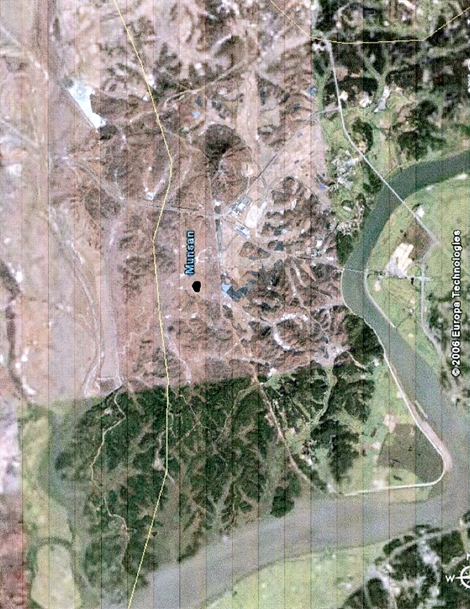 위성사진설명:군사분계선(DMZ 황색)이 위성사진의 중앙을 남북으로 표시되어 있으며 선 좌측(서쪽)은 중공군 진지지역, 우측은 해병대 진지지역이며 중앙에 흰색으로 보이는 지점이 '도라산'역, 그 북쪽에 검게 보이는 고지가 '도라산 전망대(155mm고지)'. 오른쪽을 '임진강'이 북에서 남으로(한강)흐르고 있으며 윗쪽의 교량은 '통일교', 밑의 교량은 '자유교'임.
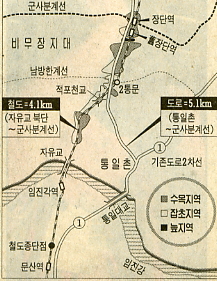 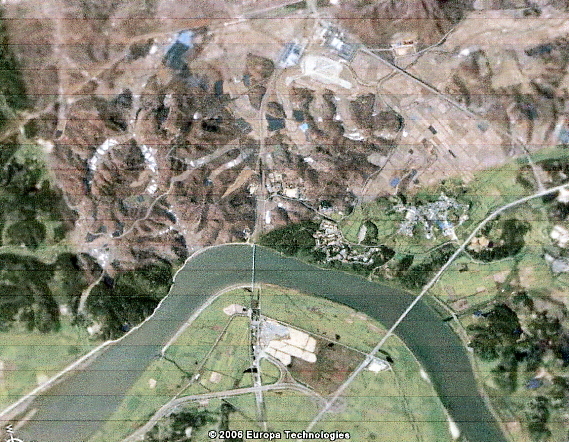 사진설명: '임진강'이 오른쪽에서 왼쪽(남쪽)으로 흘러 '한강'으로 유입되고 있으며 강 중간에 '자유교(경의선)'와 그 오른쪽에 '통일교'가 보이고 있음. 강('자유교') 너머의 도로를 중심하여 좌측 일대의 야산에 해병 제1연대가 배치되어 있었으며 도로 윗쪽의 오른쪽에 '도라산'역이 보이고 있으며 그 오른쪽에 '도라산'의 일부와 '도라산'역 및 주차장이 보이고 있음.
사진의 윗쪽에 '사천강'이 '도라산'역 북쪽에서부터 남쪽(왼쪽)으로 흘러 '임진강'으로 유입되고 있으며 이 강을 중심하여 서쪽에(윗쪽) 중공군이, 남쪽에 해병대가 각각 배치되어 있었음. 강 남쪽에 보이는 야산(강변)의 작은 구능이 해병대 전초진지였음.
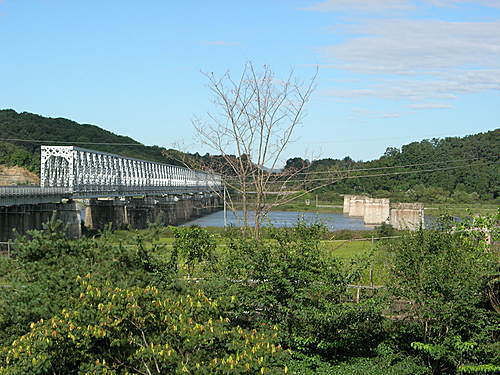
oldmarine |
'해병대 ' 카테고리의 다른 글
| 해병대 얼짱 엘리트女 3총사, 사진 봤더니… (0) | 2012.07.16 |
|---|---|
| 림팩 2012 에 참가한 대한민국 해병대 장병들... (0) | 2012.07.16 |
| 대한민국 해병대, 창설 이래 첫 美 전지훈련 떠난다 (0) | 2012.07.16 |
| 130회 도솔산 전투 (0) | 2012.07.13 |
| "도솔산 전투" 개요 (0) | 2012.07.10 |

